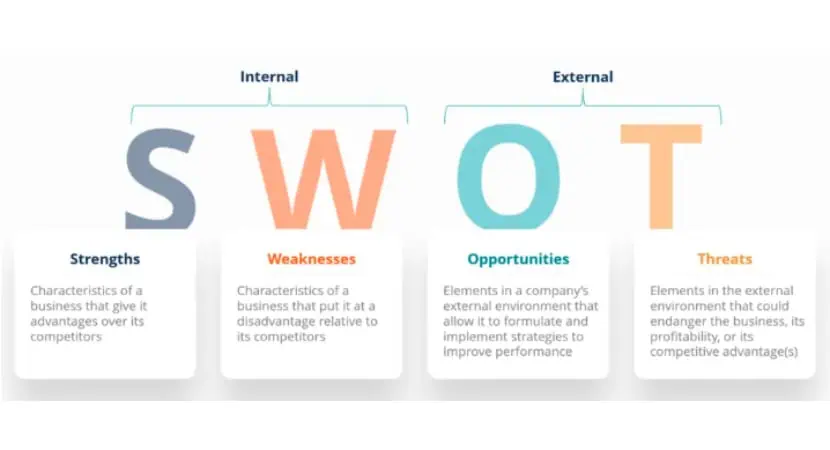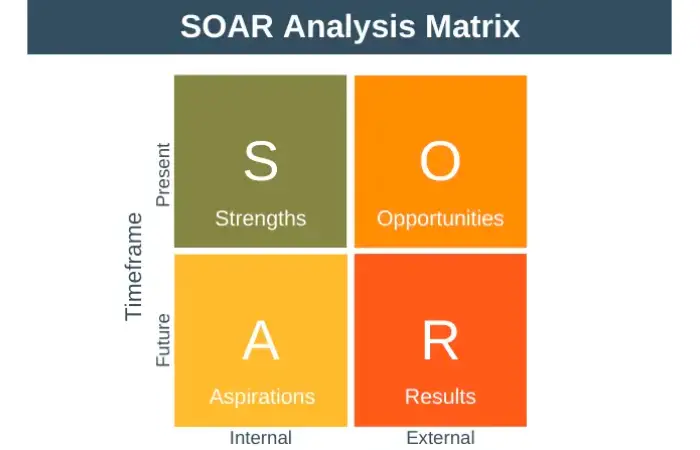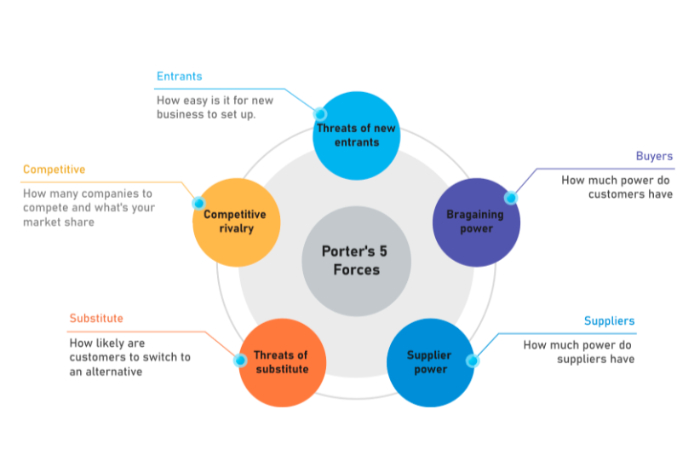The SWOT Analysis is a method by which a company or an individual can assess its strengths and weaknesses. Then, the brand fully uses its opportunities and faces the threats with its stability.
S-Strengths
W-Weaknesses
O-Opportunities
T-Threats
See also: Tesla SWOT Analysis: Everything You Should Know
4 Alternatives to a SWOT Analysis
Let’s look at those alternatives and help analyze your company’s performance and brand value according to its current state.
Read also: Lego SWOT Analysis: Building Blocks of Success
SOAR Analysis
A SOAR Analysis, along with other methodologies such as NOISE analysis, PESTEL analysis, and Porter’s Five Forces, offers a nuanced perspective by assessing a company’s strengths, opportunities, aspirations, and results—a distinctive approach compared to the traditional Four Parts of a SWOT Analysis.
S-Strengths
O-Opportunities
A-Aspirations
R-Results
In this technique, we concentrate on the strengths of the brand. Further, an analysis of the upcoming opportunities where the brand can enhance its value, recognition, and awareness occurs. Then, a discussion of brand goals and aspirations takes place.
Plans are devised according to these strengths, opportunities, goals, and aspirations. After these plans are executed, the results, reports, and analytics are judged. Further, changes are made to the plan according to the results and performed again.
Further, in SOAR Analysis, we concentrate on the brand’s positives, which can be both an advantage and a disadvantage. Thus, in SOAR analysis, when we only focus on the company’s strengths, we focus only on the positives, and this helps us move forward and better the brand value.
But, when we focus only on the positives and do not analyze and correct our mistakes, that can cause the company’s growth to cease or slow down.
Therefore, SOAR analysis is a great way to analyze your company’s performance and make necessary changes.
Visit: SOAR Analysis – A Tool For Strategic Planning
NOISE ANALYSIS
The NOISE analysis is one of the best alternatives to a SWOT analysis. The NOISE analysis can analyze the company’s performance and standing and develop plans to improve performance. It provides a more strategic way and tells you where to walk.
The NOISE analysis is more favorable as it lists the employees’ needs rather than the challenges they must face. It is a very positive and strategic form of analysis.
N-Needs
O-Opportunities
I-Improvements
S-Strengths
Firstly, the needs of the organization are listed. A detailed analysis lists the company’s needs and requirements, which lets you choose from the needs and prioritize.
Secondly, all the opportunities are evaluated, and all potential areas for improvement are recognized. This lets you clearly understand options to generate revenue or improve brand value.
Thirdly, plans and strategic ways are devised to fulfill the needs and fully use the opportunities. Improvements are made in all required areas, and maximum performance is ensured.
Fourthly, all the strengths of the organization are identified. This helps the brand to recognize and acknowledge its strong points. A company can use these strengths to advertise and differentiate itself from its competitors.
Finally, identification of the exceptions of the company takes place. Exceptions may hinder a company’s growth and hamper its performance. Identifying and eliminating these exceptions is a very step in NOISE analysis.
Thus, NOISE analysis provides a positive outlook on the company and encourages the employees to improve.
Visit: NOISE Analysis: A simple guide for SMEs and startups
PESTLE ANALYSIS
PESTLE analysis is yet another alternative to a SWOT analysis. This analysis lets you analyze the external macroeconomic factors affecting a company. Further, PESTLE stands for:
P-Political factors
E-Economic factors
S-Social factors
T-Technological factors
L-Legal factors
Thus, this analysis lets you study and judge all the factors that affect your company.
Read also: How to Do SWOT Analysis of a Leader?
The political factors let you judge how government policies, schemes, yearly financial budgets, and other political rules can affect your company’s growth. Political factors allow you to consider how the political environment can affect your brand.
The economic factors judge the financial aspect of the market that affects brand value. It examines the demand and supply, inflation rates, interest costs, and consumer spending patterns. This affects the company’s production costs and helps us to learn about the revenue generated.
Social factors involve the social and cultural factors that affect a company’s growth. Social norms, cultural values, and lifestyle trends affect social factors.
Technological factors talk about the technical aspect of the company that affects its performance and growth. A company’s growth ceases if it doesn’t adapt to changing technological trends.
Legal factors are those factors that involve the law and can later affect the performance and growth of the company. Also, a company must consider many legal factors while devising its plans.
Environmental factors also affect the growth of a company. Further, a company should consider climate change, sustainability, ecological waste, and location while making its strategies.
Thus, the PESTEL analysis is a unique way to analyze factors affecting the company’s growth which the PESTLE Analysis of Apple can better understand.
Visit: What is PESTLE Analysis? An Important Business Analysis Tool
Porter’s Five Forces
Porter’s Five Forces help companies get an in-depth understanding of their own company and its competitors. Further, Porter’s Five Forces was developed by a Harvard Business School Professor in the 1980s. It considers various macroeconomic factors that a company needs to keep in mind.
The first factor is the threat of new entrants. This factor studies the potential danger and competition posed by new competitors and analyses how they can affect our company’s performance and growth.
The second factor is the bargaining power of suppliers. This factor talks about how the availability of suppliers can affect the company. The lesser the supplier density, the more company gets affected by it.
Thirdly, the bargaining power of buyers also affects the company’s growth and performance. When buyers bargain for a product service a company provides at a lower price, the company has to lower its prices and thus find ways to reduce production costs.
Fourthly, a company also faces the threat of substitute products or services. When buyers find a substitute for a company’s products or services at a lower price, the market for the product or service decreases, thus affecting the performance.
Finally, the last factor that affects a company is the intensity of competitive rivalry, and this judges how two companies with similar products compete in the market.
Visit: Porter’s five forces analysis
FAQs
What is a SOAR Analysis?
SOAR analysis lets you judge your company's strengths, aspirations, and upcoming opportunities and thus gauge the permanence of your company.
Is PESTLE or SWOT analysis better?
PESTLE analysis is better to analyze the factors affecting a company. While SWOT analysis is better to identify the strengths and weaknesses of a company.
Why is SOAR analysis better than SWOT?
SOAR analysis is better than SWOTR analysis as it devises plans to move forward and creates a positive outlook toward the needs of the company. Whereas SWOT analysis does nothing to devise any plans and just analyses the strengths and weaknesses of the company.
What are the alternatives to a SWOT analysis?
The alternatives to a SWOT analysis are SOAR analysis, NOISE analysis, PESTLE analysis, and Porter’s Five Forces.
Conclusion
Thus, each of these alternatives can effectively analyze different aspects of your company, form reports, and improve your company’s performance accordingly.
Read also: FedEx SWOT Analysis: Things to Learn From the Shipping Giant






